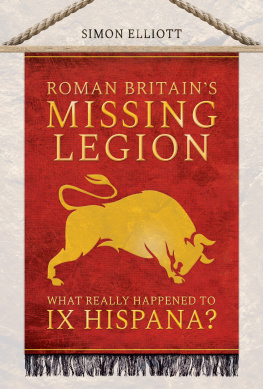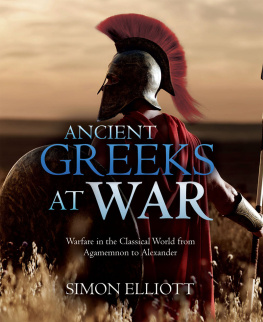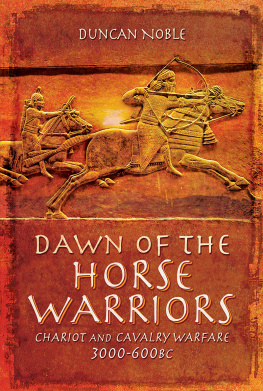Pagebreaks of the print version

OLD TESTAMENT WARRIORS
OLD TESTAMENT
WARRIORS
The Clash of Cultures in the Ancient Near East
SIMON ELLIOTT
Published in Great Britain and the United States of America in 2021 by
CASEMATE PUBLISHERS
The Old Music Hall, 106108 Cowley Road, Oxford OX4 1JE, UK
and
1950 Lawrence Road, Havertown, PA 19083, USA
Copyright 2021 Simon Elliott
Hardcover Edition: ISBN 978-1-61200-954-4
Digital Edition: ISBN 978-1-61200-955-1
Kindle Edition: ISBN 978-1-61200-955-1
A CIP record for this book is available from the British Library
All rights reserved. No part of this book may be reproduced or transmitted in any form or by any means, electronic or mechanical including photocopying, recording or by any information storage and retrieval system, without permission from the publisher in writing.
For a complete list of Casemate titles, please contact:
CASEMATE PUBLISHERS (UK)
Telephone (01865) 241249
Email:
www.casematepublishers.co.uk
CASEMATE PUBLISHERS (US)
Telephone (610) 853-9131
Fax (610) 853-9146
Email:
www.casematepublishers.com
Front cover : An early Persian soldier with a bow and spear on a ceramic panel from a patterned wall in ancient Babylon. Artefact from Iraq saved by the Pergamon Museum in Berlin. (Shutterstock)
Introduction
The bold ambition of this book is to detail conflict from the beginning of warfare itself in the Near East and Middle East from around 9,000 BC through to the onset of the Classical period around 500 BC. It encompasses a vast geographic region including the eastern Mediterranean, Levant, Mesopotamia and modern Iran. These are the lands that feature predominantly in the Bible and many other contemporary references.
In terms of scope, the chronology and geography covered are extensive. Therefore, the focus will be on those civilisations that are not only best known to us today, but which also have the most complete datasets to support the narrative. Consequently, the book is broken down into an introduction, a timeline, six chapters and a short conclusion. The timeline is particularly important to allow the reader to follow developments as the book unfolds. The chapters are then broadly chronological, following specific cultures when they were at the height of their power. The first chapter covers the origins of warfare (where the term is defined), and then focuses on the first civilisations of Mesopotamia, these including Sumer, Akkad and the Third Dynasty of Ur. The second chapter looks at the early history of Egypt, Nubia, Canaan and Libya. The third chapter details the origins of chariot warfare, with the Hyksos, Hurrians and Mitanni civilisations. The fourth chapter then turns to Europe with the Minoans, Mycenaeans and Sea Peoples. The fifth chapter returns to the Levant and the Hebrew kingdoms, while the sixth and final chapter looks at the mighty empires of the Hittites, Assyria and Babylon. Specifically, with regards to Egypt, the main period covered here refers to its early history, which is vital to understanding much of what is referenced in the book. This is due to the fact that many works on Egypt tend to concentrate on later ancient Egyptian history, and also because a sister Casemate title specifically focuses on the ancient Egyptian military through its later phases of existence. However, note that the late Egyptian military is still detailed here, though in brief, and later Egyptian-specific events, such as the battle of Kadesh in 1,274 BC are covered elsewhere in the book.
Within each chapter, specific sections detail each culture being referenced. The flow of the book first covers the chronology of the civilisation, then its general background, and finally its military establishment and organisation.
The data used in this work is based on the written word (ancient and primary sources, epigraphy, early accounting practices and graffiti), archaeology, analogy and (where appropriate) anecdote. For the former, we are blessed with multiple sources from many of the cultures mentioned. This includes, of course, the Bible itself, but also many other contemporary references. These include Egyptian hieroglyphics on wall friezes and papyrus scrolls, cuneiform writing tablets from across the entirety of the Levant and Mesopotamia, and the detailed, and often very graphic, wall reliefs of the palaces of the rulers of Assyria, Babylon and the Hittite Empire.
In terms of the definitions used for key words and titles in the book, some explanation is needed here. Firstly, the title of the book references the Old Testament. This is descriptive rather than literal, given the enormous chronological and geographical scope outlined above. Levant is used to describe the territories of modern Cyprus, Turkey, Egypt, Israel, the Palestinian territories, western Jordan and western Syria. Mesopotamia references the territories of modern eastern Jordan and Syria, Iraq and western Iran. To avoid confusion, the term Fertile Crescent has been rarely used, but when it is, it refers to the region tracking the Lower River Nile, Levantine Mediterranean coast and the Tigris and Euphrates rivers through to the Persian Gulf. Natufian is the name given to the late Mesolithic (Middle Stone Age) culture in the Levant from around 9,000 BC, where sedentary hunter-gatherers started to supplement their diet with wild and, later, cultivated grain. The Neolithic Period (New Stone Age) followed, when farming allowed the sedentary Natufian settlements to coalesce into the first farming communities. The first towns and later cities followed, these being juxtapositional terms in this book, given the differing ways the source material describes such large settlements. Finally, civilisation can be a controversial term depending on ones viewpoint. Here it means complex societies featuring urban settlement, symbolic ways of communicating, a separation from the natural environment and often in the context of those featured here social stratification imposed by societal elites.
Timeline
9,000 BC Jericho founded.
8,250 BC Pre Pottery Neolithic A (PPNA) walls of Jericho built.
7,000 BC Pottery made in the region for the first time.
6,800 BC Farming settlements begin to spread south into Mesopotamia.
6,500 BC Hassuna culture in northern Mesopotamia first to make painted pottery in the region.
6,000 BC Samarran culture flourishes in Mesopotamia. Beginning of the Predynastic Egyptian period.
5,900 BC Ubaid culture flourishes in southern Mesopotamia.
5,500 BC Farming settlements now found across the entirety of Mesopotamia.
5,400 BC Ubaid culture replaces Halafian culture in northern Mesopotamia.
4,300 BC Beginning of the Uruk period of Sumerian expansion.
3,500 BC Sodom and Gomorrah founded.
3,300 BC First major towns appear in the Nile Valley.
3,150 BC Beginning of the Early Dynastic Egyptian period.
3,000 BC King Narmer of Upper Egypt conquers Lower Egypt, uniting the two for the first time.
2,900 BC Beginning of the Sumerian Early Dynastic Period.
2,800 BC End of Nubian A-Group culture.
2,700 BC Minoan culture begins to flourish in Greece.
2,600 BC Assyrian city of Assur founded.
2,500 BC Beginning of Nubian C-Group culture.
2,686 BC Beginning of the Old Kingdom Egyptian period.
2,668 BC Accession of Egyptian king Djoser, builder of Egypts first step pyramid.
















